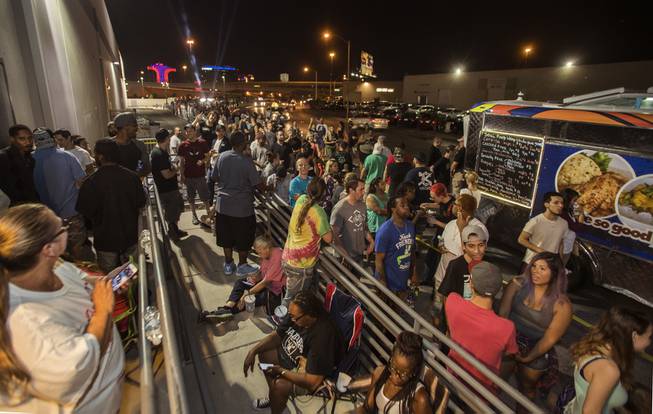
Customers wait in a long line at Reef Dispensaries in Las Vegas as recreational marijuana sales begin at midnight in Nevada on Friday, June 30, 2017.
Monday, July 10, 2017 | 2 a.m.
Economic impact of recreational marijuana on Nevada
• 500: People waiting in line at Reef Dispensary, 3400 Western Ave., before its midnight opening on July 1.
• 35-38%: Percentage recreational pot buyers are taxed on the product (including the future wholesale tax), depending on local rates.
• $500M: Estimated sales over the next two years.
• $110M: Estimated tax revenue over the next two years.
• 3,298: Direct full-time jobs projected to be created by the industry by 2020.
8-10%
THC count of Pennywise, one of the mildest strains sold in Las Vegas.
25-28%
THC count of Gorilla Glue #4, one of the most potent strains sold in Las Vegas.
When legislators estimated that as much as $100 million in state tax revenue could be generated in the first two years of Nevada’s recreational marijuana industry, they couldn’t have seen this coming.
Through the first four days of legalization, starting July 1, the new industry made $3 million in sales, according to the Nevada Dispensary Association (NDA). That breaks down to $750,000 per day, and about $125,000 in state taxes. The tax revenue number would have been higher had a 15 percent wholesale distribution tax been applied, but dispensaries were still operating off medical marijuana stashes distributed before July 1.
“It has been a wild ride,” said NDA President Andrew Jolley, who owns The+Source dispensary in Las Vegas. “It has definitely met and exceeded expectations. ... It’s hard to say, but I think we’ll see sales taper off in the coming weeks and then start a slow, consistent growth after that point.”
In Alaska, tax revenue generated by recreational marijuana sales grew in all but one month from the start of legal weed sales in October 2016 — $10,400 — to May of this year — $272,100. And the number of dispensaries selling recreational pot jumped from four to 31 in that time.
Washington and Oregon have seen similar growth since kicking off recreational programs in July 2014 and October 2015, respectively. After doing about $65 million in sales in 2015, Washington brought in more than $185 million in tax revenue from pot sales last year. Oregon, which once generated less than $2.5 million a month in tax revenue from the plant, brought in almost $5.8 million in May.
It’s tough to project Nevada’s future, but its new industry has momentum.
Only 40 of the state’s 60 medical marijuana dispensaries were open for the start of recreational sales, but an additional eight to 10 in Northern Nevada could enter the industry this month, and five more will be rec-ready when a six-month moratorium on weed sales in Henderson expires in August. That leaves fewer than five dispensaries statewide saying they’re sticking to the medical model for the time being, and debating starting recreational sales Jan. 1.
“The more dispensaries you have, the more opportunity you give to tourists and locals to purchase and get used to it,” state Sen. Tick Segerblom, D-Las Vegas, said of a growing retail landscape serving a more normalized and lucrative marijuana industry. “It will absolutely help.”
GROWING PAINS OR GOOD OMEN?
While existing recreational marijuana license holders increased their staffs and inventories to accommodate the rush of new buyers, the logistics of selling to thousands of added customers overnight will take time to hammer out. Some Nevada dispensaries reported slow computers and long customer wait times in their first few days of serving recreational buyers. Dispensaries in other states have experienced that as well.
“It takes time to give customers the service they need,” said Sam Heywood, owner of Farma Dispensary in Portland, Ore. “It’s a challenge because you’re not used to dealing with that kind of volume.”
Like Nevada officials, Heywood says an encouraging first weekend of sales is a telling sign for the future of a state’s recreational weed program. Since increasing his own clientele tenfold overnight in October 2015, Heywood says he now routinely exceeds that customer count on a daily basis. “It was pretty clear to us that this was here to stay and we’d need to staff up. We were in a completely different world at that point.”

Join the Discussion:
Check this out for a full explanation of our conversion to the LiveFyre commenting system and instructions on how to sign up for an account.
Full comments policy